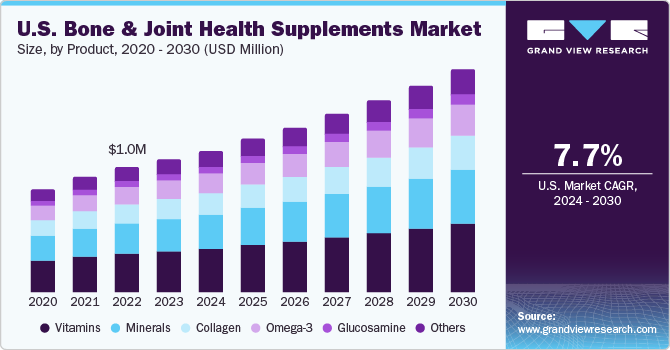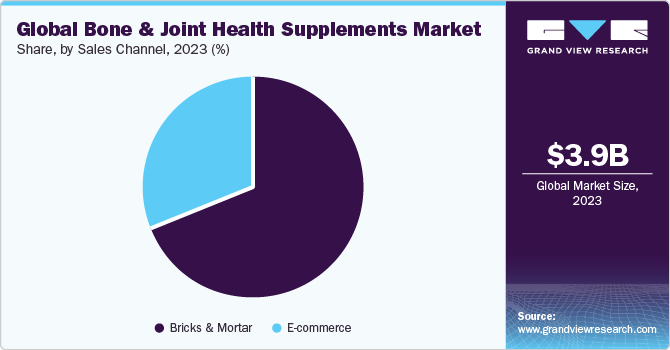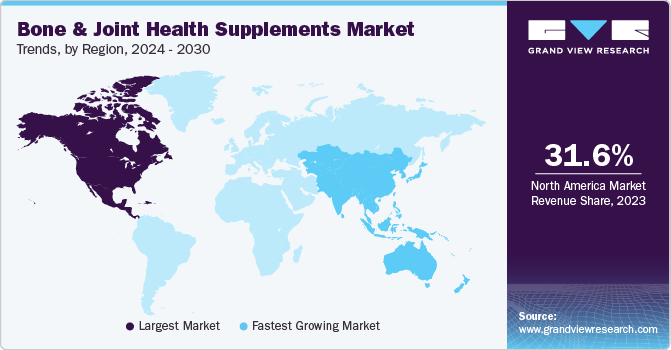- Home
- »
- Pharmaceuticals
- »
-
Bone And Joint Health Supplements Market Report, 2030GVR Report cover
![Bone And Joint Health Supplements Market Size, Share & Trends Report]()
Bone And Joint Health Supplements Market Size, Share & Trends Analysis Report By Product (Vitamins, Mineral, Collagen, Omega-3, Glucosamine), By Formulation, By Consumer Group, By Sales Channel, By Region, And Segment Forecasts, 2024 - 2030
- Report ID: GVR-4-68039-974-6
- Number of Report Pages: 130
- Format: PDF, Horizon Databook
- Historical Range: 2018 - 2022
- Forecast Period: 2024 - 2030
- Industry: Healthcare
Market Size & Trends
The global bone and joint health supplements market size was estimated at USD 3.90 billion in 2023 and is expected to grow at a compound annual growth rate (CAGR) of 7.26% from 2024 to 2030. Factors such as rapidly growing geriatric population, prevalence of orthopedic disorders, and rising awareness regarding micronutrient deficiencies are driving this growth. As per the World Health Organization (WHO), around 1.4 billion of global population will be of age above 60 years by 2030. The population suffering from rheumatoid arthritis is expanding at a considerable rate, mainly due to increasing life expectancy, which is, in turn, creating demand for bone and joint health supplements.

COVID-19 pandemic has boosted awareness regarding healthy and active lifestyles and has increased the implementation of self-care among consumers. This raised the adoption of various health supplements. Also, the joint health product category is attracting Gen Z population owing to the rising joint discomfort caused by a sedentary lifestyle. The increasing interest of younger generation in joint health and mobility with various fitness and active lifestyle goals is anticipated to impel industry growth.
Increasing focus of market players on developing joint health supplements with different compositions is further attracting the consumer base. An increasing number of collagen product launches is positively impacting this market’s growth. New approaches to joint and bone health using innovative forms of collagen and botanicals are expected to drive growth prospects. The Asian population is considerably recognizing collagen for bone health, thereby creating an opportunity for players to expand their footprints in Asia.
In addition, COVID-19 outbreak shifted the trend toward e-commerce. An increasing number of people opting for online platforms is significantly impacting the industry's growth. For instance, Amazon witnessed a significant rise in online sales of nutritional supplements, particularly in the U.S., due to COVID-19, thereby impelling industry growth.
Market Dynamics
Changing lifestyle and eating habits have resulted in nutrient deficiency, which is expected to increase consumption and demand for nutritional supplements. In addition, an increase in working age and middle-class population is anticipated to boost demand in near future. It has been noticed that in the MENA region, the GDP annual growth rate increased by 4.2% in 2021. This is expected to increase purchasing power of consumer goods, thereby resulting in a rise in regional demand for sports nutrition products.
Similarly, it is estimated that the average household income in India may increase three-fold in the next two decades, and by 2025, the country will have the world’s fifth-largest consumer economy. In addition, disposable personal income in the U.S. increased by 0.4% in October 2022 from the previous month. Convergence of these factors is expected to boost this market’s growth.
However, recession and inflation might impact the bone and joint health supplements market. Contract manufacturers in the dietary supplement and functional food industry are preparing for the worst-case scenario. Inflation has a direct influence on consumer pockets and might disrupt disposable income, thereby negatively impacting growth.
Product Insights
Vitamins segment held a dominant revenue share of 30.76% in 2023. This can be attributed to the growing adoption of healthy lifestyles, increasing life expectancy, and rising focus on active lifestyles. Also, increasing consumption of vitamin D supplements to reduce the risk of bone fracture is impelling this segment’s growth. Also, vitamin K is linked to bone density and subsequently is found to be effective for bone health. It is consumed by people suffering from osteoporosis to reduce the risk of fracture, which is expected to drive segment’s growth.
Glucosamine segment is expected to grow at the fastest CAGR of 8.74% from 2024 to 2030. These supplements offer health benefits, especially for joint pain such as arthritis. Studies across the globe have shown that glucosamine helps relieve joint pain, especially in people suffering from osteoarthritis. Scientific backing for glucosamine is so strong that in the UK and other European countries, glucosamine compound is available as a medicinal substance and not just a dietary supplement. Supplements combined with glucosamine and chondroitin have shown similar effectiveness as osteoarthritis drugs like CeleBREX. This aids in driving the glucosamine segment’s growth.
Formulation Insights
Capsules segment held the largest revenue share of over 36.33% in 2023. Availability of product types in various forms of encapsulations is responsible for an increase in the bioavailability of active ingredients. Multilayered or multi-membrane encapsulations, extended-release capsules for vitamins and minerals, and omega-3 fatty acids are some of the products currently available in capsule formulations, which have been responsible for the industry’s growth.
Powder formulations segment is expected to grow at the fastest CAGR of 9.11% from 2024 to 2030. Powder formulations have captured the market and have been preferentially used in comparison to soft chews and soft gels due to their ease of consumption. Growing demand for powdered vitamin supplements has led to the high growth of this segment.
Consumer Group Insights
Geriatric population segment held the largest revenue share of over 33.95% in 2023. Geriatric population is a major consumer of bone and joint health supplements as the prevalence of bone disorders rises with aging. Osteoporosis is the most common disorder in elders. As per a study, in 2021 the prevalence of osteoporosis in India was 36.1% among geriatric population. Also, in the U.S., about 1.5 million fractures occur due to osteoporosis each year. This in turn is contributing to increased demand from this age group looking to prevent fractures and maintain bone health.
Adult segment is expected to grow at the fastest CAGR from 2024 to 2030, owing to increasing awareness regarding nutritional supplements. With rising trend of healthy and active lifestyles, adults are consuming various supplements to maintain bone health. As per the CRN survey, around 18% of people aged 18 to 34 years and 19% of people aged 35 to 54 years consume bone health dietary supplements. This number is expected to further rise due to an increase in adult population suffering from arthritis. As per the CDC, around 57.3% of adult population in the U.S. suffer from arthritis.
Sales Channel Insights
Bricks and mortar segment held the largest revenue share of over 69.12% in 2023. Rising number of retail stores selling supplements for bone and joint health with a wide variety of product types of different brands is one of the key factors responsible for this segment’s growth. Companies are investing in more stores to reach a larger population base and meet evolving consumer demand, which is further contributing to this growth.

E-commerce segment is expected to witness the fastest CAGR during the forecast period. Online sales channels have witnessed substantial growth during COVID-19. These channels emerged as a strategy to increase geographical reach. Market players are collaborating with e-commerce platforms to make their product types available online, which is positively impacting market’s growth. Moreover, rising consumer preference for online shopping is expected to drive this growth. As per the report by Mintel, 50% of consumers prefer online shopping for mineral and vitamin supplements.
Regional Insights
North America accounted for the largest revenue share of over31.64% in 2023. Increasing geriatric population and rising number of people suffering from joint pain are some of the factors driving regional market growth. As per the CDC, nearly 14.6 million people are diagnosed with severe joint pain. Moreover, increasing prevalence of arthritis is fueling the industry's growth. In Canada, approximately 6 million people are diagnosed with arthritis. Increasing awareness regarding overall health is further impelling growth. As per a survey conducted by NMI in the U.S., around 37% of supplement consumers are likely to use bone and joint health supplements. Also, high prevalence of micronutrient deficiencies among adults is boosting demand for these supplements.

Asia Pacific is anticipated to grow at the fastest CAGR of 8.20% from 2024 to 2030 due to rising awareness regarding health and well-being coupled with nutritional deficiencies. Increasing prevalence of vitamin D deficiency and osteoporosis has contributed to the demand for various supplements supporting bone and joint health. With increasing disposable income, consumers are willing to pay more for supplements to maintain health, thereby positively impacting overall growth. Various strategies adopted by market players to strengthen industry growth are also boosting regional growth.
Key Companies & Market Share Insights
Key players are undertaking various strategic initiatives to maintain their market presence. Various strategic initiatives help these players bolster their business avenues.
-
For instance, in March 2023 FlexAgain revealed its plans to introduce joint supplements on popular third-party marketplaces such as Amazon. The decision to launch on these platforms was driven by increasing demand for dietary supplements and growing predominance of e-commerce.
-
In September 2023, Voltaren launched its Joint Comfort & Movement Daily Supplement and Joint Health & Bone Strength Dietary Supplement to strengthen its market position.
Key Bone And Joint Health Supplements Companies:
- Herbalife International of America, Inc.
- GNC Holdings, LLC
- Nature's Bounty
- BYHEALTH Co., Ltd.
- Amway
- BASF SE
- Bayer AG
- Vitalife Ltd
- Glanbia plc
- NOW Foods
Bone And Joint Health Supplements Market Report Scope
Report Attribute
Details
Market size value in 2024
USD 4.16 billion
Revenue forecast in 2030
USD 6.33 billion
Growth rate
CAGR of 7.26% from 2024 to 2030
Base year for estimation
2023
Historical data
2018 - 2022
Forecast period
2024 - 2030
Quantitative units
Revenue in USD million/billion, CAGR from 2024 to 2030
Report coverage
Revenue forecast, company ranking, competitive landscape, growth factors, and trends
Segments covered
Product, formulation, consumer group, sales channel, region
Regional scope
North America; Europe; Asia Pacific; Latin America; MEA
Country scope
U.S.; Canada; Germany; U.K.; France; Italy; Spain; Denmark; Sweden; Norway; China; Japan; India; South Korea; Australia; Thailand; Brazil; Mexico, Argentina; South Africa; Saudi Arabia, UAE; Kuwait
Key companies profiled
Herbalife International of America, Inc.; GNC Holdings, LLC; Nature's Bounty; BYHEALTH Co., Ltd.; Amway; BASF SE; Bayer AG; Vitalife Ltd; Glanbia plc; NOW Foods
Customization scope
Free report customization (equivalent up to 8 analyst’s working days) with purchase. Addition or alteration to country, regional & segment scope.
Global Bone And Joint Health Supplements Market Report Segmentation
This report forecasts revenue growth and analyzes latest trends in each sub-segment from 2018 to 2030. For this report, Grand View Research has segmented the global bone and joint health supplements market report based on product, formulation, consumer group, sales channel, and region:
-
Product Outlook (Revenue, USD Million, 2018 - 2030)
-
Vitamins
-
Minerals
-
Collagen
-
Omega-3
-
Glucosamine
-
Others
-
-
Formulation Outlook (Revenue, USD Million, 2018 - 2030)
-
Capsules
-
Tablets
-
Powders
-
Softgels
-
Others
-
-
Consumer Group Outlook (Revenue, USD Million, 2018 - 2030)
-
Infants
-
Children
-
Adults
-
Pregnant Women
-
Geriatric Population
-
-
Sales Channel Outlook (Revenue, USD Million, 2018 - 2030)
-
Bricks and Mortar
-
Direct Selling
-
Chemists/Pharmacies
-
Health Food Shops
-
Hypermarkets
-
Supermarkets
-
-
E-commerce
-
-
Regional Outlook (Revenue, USD Million, 2018- 2030)
-
North America
-
U.S.
-
Canada
-
-
Europe
-
Germany
-
U.K.
-
France
-
Italy
-
Spain
-
Denmark
-
Sweden
-
Norway
-
-
Asia Pacific
-
China
-
India
-
Japan
-
South Korea
-
Australia
-
Thailand
-
-
Latin America
-
Brazil
-
Mexico
-
Argentina
-
-
Middle East and Africa (MEA)
-
South Africa
-
Saudi Arabia
-
UAE
-
Kuwait
-
-
Frequently Asked Questions About This Report
b. The global bone and joint health supplements market size was estimated at USD 3.90 billion in 2023 and is expected to reach USD 4.16 billion in 2024.
b. The global bone and joint health supplements market size is expected to grow at a compound annual growth rate of 7.26% from 2024 to 2030 to reach USD 6.33 billion by 2030.
b. Vitamin segment dominated the global bone and joint supplements market with a share of 30.76% in 2023. This is attributable to the rising prevalence of vitamin D deficiency among adults and rising consumption of vitamin D to reduce the risk of bone fracture.
b. Some of the key players operating in the global bone and joint health supplements market include Herbalife International of America, Inc., GNC Holdings, Inc., Nature’s Bounty Co., Bayer AG, BY-HEALTH Co., Ltd., etc.
b. Key factors that are driving bone and joint health supplements market growth include the growing geriatric population, increasing prevalence of orthopedic disorders, and rising awareness of micronutrient deficiencies.
Share this report with your colleague or friend.
![gvr icn]()
NEED A CUSTOM REPORT?
We can customize every report - free of charge - including purchasing stand-alone sections or country-level reports, as well as offer affordable discounts for start-ups & universities. Contact us now
![Certified Icon]()
We are GDPR and CCPA compliant! Your transaction & personal information is safe and secure. For more details, please read our privacy policy.
We are committed towards customer satisfaction, and quality service.
"The quality of research they have done for us has been excellent."





